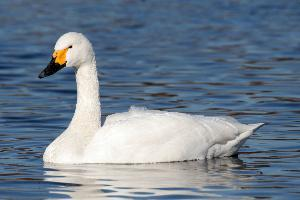
Descrierea animalului
The Tundra Swan, scientifically known as Cygnus columbianus, is a captivating bird species renowned for its elegance and grace. This species of swan is primarily found in the cold tundra regions of North America and migrates to warmer areas during the winter months. The Tundra Swan is distinguishable from other swans by its smaller size, more rounded head shape, and the characteristic yellow spot in front of the eye, although this feature may not be present in all individuals.Adult Tundra Swans boast a stunning pure white plumage that beautifully contrasts against the natural landscapes they inhabit. Their long, slender necks, which they often hold in a graceful curve, add to their elegant appearance. The birds' black bills, legs, and feet stand out against their white feathers, making them easily identifiable in their natural habitats.
Tundra Swans are highly social birds, often found in large flocks, especially during migration and in their wintering grounds. These flocks can sometimes number in the thousands, creating spectacular sights against the sky. They are known for their loud, trumpeting calls, which can be heard over long distances and add to the ambiance of their environments.
The diet of the Tundra Swan is quite varied and includes aquatic vegetation, grains, and small aquatic organisms. They are often seen dipping their heads underwater in shallow waters to forage for food, using their long necks to reach vegetation submerged below the surface.
Breeding season for Tundra Swans is in the late spring and summer months when they return to the Arctic tundra. They are monogamous birds, forming long-term pair bonds that can last many years. Nests are built on the ground near water bodies, using vegetation to construct a large, sturdy platform. Females typically lay 3 to 5 eggs, which they incubate for about a month. Both parents are involved in raising the young, which are born covered in down and are able to swim shortly after hatching.
Tundra Swans undertake one of the most remarkable migrations of any North American bird species. They travel thousands of miles between their breeding grounds in the Arctic and their wintering grounds in the coastal and southern freshwater marshes, fields, and estuaries. During migration, they can be seen flying in V-shaped formations at high altitudes, a strategy that helps conserve energy.
Despite facing threats such as habitat loss and pollution, Tundra Swan populations remain relatively stable, thanks in part to conservation efforts. They are protected under the Migratory Bird Treaty Act in the United States and by similar legislation in other countries. Birdwatchers and nature enthusiasts cherish the opportunity to observe these magnificent birds, whether in their serene breeding grounds in the far north or along their migration routes.
In conclusion, the Tundra Swan is a symbol of wilderness and natural beauty. Its life cycle, from the epic migrations to the nurturing of its young in the secluded tundra, showcases the resilience and adaptability of wildlife. The Tundra Swan not only contributes to the biodiversity of its habitats but also inspires those who witness its majestic presence.
Animale similare
Fotografii noi cu animale
Top 10 animale
- Dolphin gull (Leucophaeus scoresbii)
- Diana monkey (Cercopithecus diana)
- Moustached guenon (Cercopithecus cephus)
- Galápagos tortoise (Geochelone nigra complex)
- Greek tortoise (Testudo graeca)
- Stone loach (Barbatula barbatula)
- Japanese macaque (Macaca fuscata)
- Russian tortoise (Testudo horsfieldii)
- Common flying dragon (Draco volans)
- Galápagos penguin (Spheniscus mendiculus)


